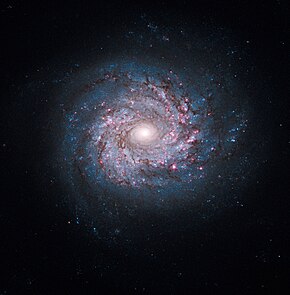NGC 3982 (also known as UGC 6918) is an intermediate spiral galaxy approximately 68 million light-years away in the constellation Ursa Major. It was discovered by William Herschel on April 14, 1789, and misclassified as a planetary nebula.[4] NGC 3982 is a part of the M109 Group.
| NGC 3982 | |
|---|---|
 NGC 3982 as taken by the Hubble Space Telescope | |
| Observation data (J2000 epoch) | |
| Constellation | Ursa Major |
| Right ascension | 11h 56m 28.1s[1] |
| Declination | +55° 07′ 31″[1] |
| Redshift | 1109 ± 6 km/s[1] |
| Distance | 67.8 ± 2.5 Mly (20.80 ± 0.77 Mpc)[2] 70.38 ± 0.23 Mly (21.58 ± 0.07 Mpc)[3] |
| Group or cluster | M109 Group |
| Apparent magnitude (V) | 12.0[1] |
| Characteristics | |
| Type | SAB(r)b[1] |
| Apparent size (V) | 1.7′ × 1.5′[1] |
| Other designations | |
| UGC 6918,[1]PGC 37520[1] | |
At an apparent magnitude of 12.0, NGC 3982 needs a telescope to be viewed. Using small telescopes, the galaxy appears as a very faint, diffuse patch of light, with its central region appearing as a slightly brighter diffuse ball.
General
editNGC 3982 is a Seyfert 2 galaxy that spans about 30,000 light-years, about one-third of the size of our Milky Way galaxy. The galaxy is receding from us at about 1,109 km/s. The galaxy is a typical spiral galaxy, similar to our Milky Way. It harbors a supermassive black hole at its core and has massive regions of star formation in the bright blue knots in the spiral arms.[5] Supernovae are likely to be found within these regions.
NGC 3982 has a high rate of star birth within its arms, which are lined by pink star-forming regions of glowing hydrogen and newborn blue star clusters. Its bright nucleus is home to older populations of stars, which grow more densely packed toward the center. The galaxy also has active star formation in the circumnuclear region, estimated at 0.52 M☉/year. The HST image of NGC 3982 shows a mini-spiral between the circumnuclear star-forming region and the galaxy's nucleus, which could be the channel through which gas is transported to the supermassive black hole from the star-forming region.
NGC 3982 is a member of the M109 Group, a group of galaxies located in the constellation Ursa Major that may contain over 50 galaxies. The group was named after the brightest galaxy in the group, the spiral galaxy M109.[6][7][8]
Astronomers are interested in studying this galaxy as it can help in measuring extragalactic distances. It is helpful because it possesses two tools used to estimate astronomical distances: supernovae and Cepheid variable stars.
Supernova 1998aq
editIn 1998, the light from a supernova in NGC 3982 (later called SN 1998aq) reached Earth and was discovered by British amateur astronomer Mark Armstrong. It was discovered when it had an apparent magnitude of 14.9, and had grown considerably brighter by two days after its initial sighting (it reached maximum magnitude 14.0).
The supernova explosion resulted from a binary system in which a white dwarf star was capturing mass from its companion star. When the white dwarf had gathered enough mass and was no longer able to support itself, the star detonated in a violent and extremely bright explosion.
Since a supernova occurs in a typical spiral galaxy (roughly) once every 100 years, astronomers have software continuously monitor high-resolution automatic survey camera images of galaxies like NGC 3982, for early detection of supernova explosions.
References
edit- ^ a b c d e f g h "NASA/IPAC Extragalactic Database". Results for NGC 3982. Retrieved 2006-11-16.
- ^ Riess, Adam G.; Li, Weidong; Stetson, Peter B.; Filippenko, Alexei V.; et al. (2005). "Cepheid Calibrations from the Hubble Space Telescope of the Luminosity of Two Recent Type Ia Supernovae and a Redetermination of the Hubble Constant". Astrophysical Journal. 627 (2): 579–607. arXiv:astro-ph/0503159. Bibcode:2005ApJ...627..579R. doi:10.1086/430497. S2CID 7590029.
- ^ Tully, R. Brent; et al. (October 2013). "Cosmicflows-2: The Data". The Astronomical Journal. 146 (4): 25. arXiv:1307.7213. Bibcode:2013AJ....146...86T. doi:10.1088/0004-6256/146/4/86. S2CID 118494842. 86.
- ^ NGC 3982. Students for the Exploration and Development of Space. Retrieved March 3, 2009
- ^ Zhang, Shui-Nai; Gu, Qiu-Sheng; Wang, Yi-Peng (2008). "Circumnuclear star forming activity in NGC 3982". Chinese Journal of Astronomy and Astrophysics. 8 (5): 555. Bibcode:2008ChJAA...8..555Z. doi:10.1088/1009-9271/8/5/06.
- ^ Tully, R.B. (1988). Nearby Galaxies Catalog. Cambridge University Press. ISBN 978-0-521-35299-4.
- ^ Fouque, P.; Gourgoulhon, E.; Chamaraux, P.; Paturel, G. (1992). "Groups of galaxies within 80 Mpc. II - The catalogue of groups and group members". Astronomy and Astrophysics Supplement Series. 93 (2): 211–233. Bibcode:1992A&AS...93..211F.
- ^ Giuricin, G.; Marinoni, C.; Ceriani, L.; Pisani, A. (2000). "Nearby optical galaxies: Selection of the sample and identification of groups". Astrophysical Journal. 543 (1): 178–194. arXiv:astro-ph/0001140. Bibcode:2000ApJ...543..178G. doi:10.1086/317070. S2CID 9618325.
External links
edit- Spiral Galaxy NGC 3982 @ SEDS NGC objects pages
- Stetson, Peter B.; Gibson, Brad K. (2001). "The Distance to Supernova 1998aq in NGC 3982". Monthly Notices of the Royal Astronomical Society. 328 (1): L1. arXiv:astro-ph/0110062. Bibcode:2001MNRAS.328L...1S. doi:10.1046/j.1365-8711.2001.05005.x. S2CID 119461606.
- NGC 3982 at ESA/Hubble
- Circumnuclear Star Forming Activity in NGC 3982 Archived 2016-03-04 at the Wayback Machine